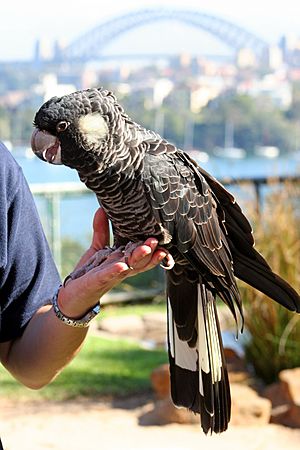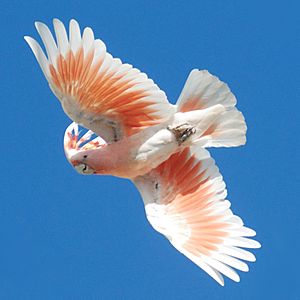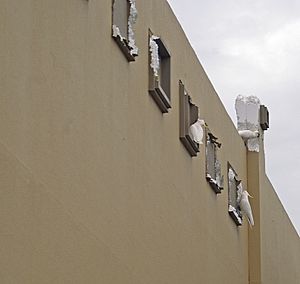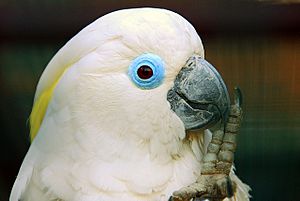Cockatoo facts for kids
Quick facts for kids Cockatoo |
|
|---|---|
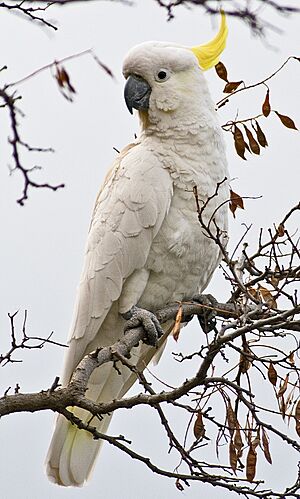 |
|
| Sulphur-crested cockatoo | |
| Scientific classification |
|
| Kingdom: | Animalia |
| Phylum: | Chordata |
| Class: | Aves |
| Order: | Psittaciformes |
| Superfamily: | Cacatuoidea |
| Family: | Cacatuidae G. R. Gray 1840 |
| Type genus | |
| Cacatua Vieillot 1817
|
|
| Genera | |
|
|
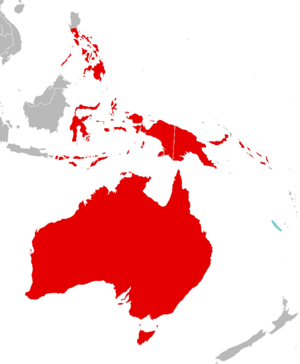 |
|
| Current range of cockatoos – red Finds of recent fossils – blue |
|
| Synonyms | |
|
|
A cockatoo is a type of parrot. There are 21 different kinds, or species, of cockatoos. They all belong to the bird family called Cacatuidae. You can find cockatoos mainly in Australasia, which includes places like the Philippines, Indonesia, New Guinea, the Solomon Islands, and Australia.
Cockatoos are easy to spot because of their cool, feathery crests on their heads and their strong, curved bills. Unlike some other parrots, cockatoos usually have feathers that are white, grey, or black. Sometimes, they have bright colors like yellow, pink, or red on their crests, cheeks, or tails. Most cockatoos are bigger than other parrots. However, the cockatiel is the smallest cockatoo and is only medium-sized.
Cockatoos love to eat seeds, roots, fruits, flowers, and insects. They often eat in big groups, especially when they are looking for food on the ground. Cockatoos usually stay with one partner for life and build their nests in tree hollows. Sadly, some cockatoo species are losing their homes because big trees are being cut down. But other species have learned to live well near humans and are sometimes even seen as pests by farmers.
Many people like to keep cockatoos as pets, but they need a lot of care. The cockatiel is the easiest cockatoo to look after and is the most popular pet cockatoo. White cockatoos are also common pets. Sometimes, wild cockatoos are caught illegally and sold, which hurts their populations in nature.
Contents
What's in a Name?
The word "cockatoo" comes from the Dutch word kaketoe. This word itself came from the Indonesian and Malay word kakatua. People started using "cockatoo" in the 1600s.
In Australia, people sometimes use the word "cockatoo" in a fun way. If someone is a "cockatoo," it means they are keeping watch while others are doing something secret. Farmers who own small farms are sometimes jokingly called "cocky farmers."
Types of Cockatoos
Cockatoos are part of a larger group of birds called Psittaciformes, which includes all parrots. Scientists have studied cockatoos for a long time. They found that cockatoos are a distinct group of parrots, separate from the "true parrots" and the large New Zealand parrots.
The cockatiel is a unique cockatoo. It's the smallest and branched off very early in the cockatoo family tree. The other cockatoo species fall into two main groups. One group includes the five large black cockatoos, like the Red-tailed black cockatoo. The second, larger group includes 12 species of white cockatoos, like the Sulphur-crested cockatoo. This group also includes the pink and grey galah, the grey gang-gang cockatoo, and the big black palm cockatoo.
Scientists have also found very old cockatoo fossils. One fossil, found in Australia, is about 16 to 23 million years old! It looks similar to today's western corella and the galah.
Genera and Species of Cockatoos
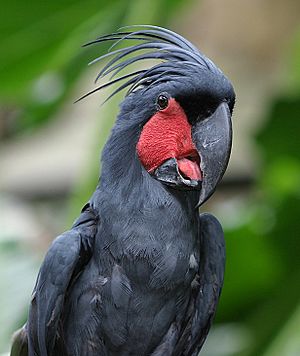
There are about 44 different kinds of birds in the cockatoo family, including their subspecies. Here are some of the main groups and species:
- Cockatiel (Nymphicus hollandicus)
- Black Cockatoos (Genus Calyptorhynchus and Zanda)
- Palm Cockatoo (Probosciger aterrimus)
- Gang-gang Cockatoo (Callocephalon fimbriatum)
- Galah (Eolophus roseicapilla)
- White and Pink Cockatoos (Genus Cacatua and Lophochroa)
- Yellow-crested cockatoo
- Sulphur-crested cockatoo
- White cockatoo (also called Umbrella Cockatoo)
- Salmon-crested cockatoo (also called Moluccan Cockatoo)
- Long-billed corella
- Little corella
- Tanimbar corella (also called Goffin's Cockatoo)
- Pink cockatoo (also called Major Mitchell's or Leadbeater's Cockatoo)
What Do Cockatoos Look Like?

Cockatoos are usually medium to large birds. They can be from 30 to 60 cm (12 to 24 in) long. The cockatiel is much smaller, only about 32 cm (13 in) long. All cockatoos have a crest of feathers on their head that they can raise up. This crest is very noticeable in many species, especially when the bird is excited or landing from a flight.
Like other parrots, cockatoos have a curved beak and special feet called "zygodactyl" feet. This means two toes point forward and two toes point backward, which helps them climb and hold food. They also have short legs and strong claws. Their bills are very strong and they keep them sharp by rubbing the two parts together. They use their big, muscular tongue to help them eat seeds.
Cockatoos usually have less colorful feathers than other parrots. Their feathers are mostly black, grey, or white. But many species have splashes of yellow, pink, or red, often on their crests or tails. The galah and pink cockatoo are mostly pink. Some cockatoos have a bright, bare patch of skin around their eyes. For example, the palm cockatoo has a large red patch on its face.
In most cockatoo species, males and females look similar. However, female cockatiels are duller than males. Also, female gang-gang cockatoos and some black cockatoos have different feather patterns than the males. The color of their eyes can also be different. For example, female galahs and pink cockatoos have pink or red eyes, while males have dark brown eyes.
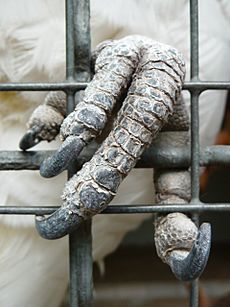
Cockatoos spend a lot of time cleaning their feathers. They remove dirt and oil and straighten their feathers by nibbling them. They also help clean other cockatoos' feathers in hard-to-reach spots. Cockatoos have a special gland that produces oil, which they spread on their feathers to keep them healthy. They also produce a fine powder from special feathers that helps keep their plumage clean.
Sounds and Communication
The sounds cockatoos make are usually very loud and harsh. They use these calls for many reasons. They help individual birds recognize each other and warn others about dangers like predators. Calls also show a bird's mood, keep the flock together, and warn other birds away from their nests. Different cockatoo species have different numbers and types of calls. Some, like the gang-gang cockatoo, are quieter and make softer growling sounds when they eat.
Interestingly, palm cockatoos can communicate over long distances by drumming on a dead branch with a stick! Cockatoos also make a hissing sound when they feel threatened.
Where Do Cockatoos Live?

Cockatoos live only in Australia, Indonesia, the Philippines, and some islands in the Pacific Ocean. Most species, 11 out of 21, live only in Australia. Seven species live only on islands like the Philippines, Indonesia, Papua New Guinea, and the Solomon Islands. You won't find cockatoos naturally in Borneo or many other Pacific islands.
Some cockatoo species, like the galah, live in many different places across Australia. Others, like the Baudin's black cockatoo, live only in a small area. Some cockatoos have accidentally been introduced to new places like New Zealand and Singapore.
Cockatoos live in many different environments, from forests in cold, high mountains to mangrove swamps. However, no single species lives in all these places. Species like the galah and cockatiel prefer open areas and eat grass seeds. They often fly fast and move around a lot to find food. Other cockatoos, like the glossy black cockatoo, live in woodlands and rainforests. Some cockatoos have adapted well to living near people, even in cities and farming areas.
Cockatoo Behavior
Cockatoos are active during the day and need daylight to find food. They are not early risers; they wait for the sun to warm up their roosting spots before they start looking for food. All cockatoos are very social birds. They live, eat, and travel in colorful and noisy flocks. The size of these flocks can change. When there's plenty of food, flocks are small. But during droughts or hard times, they can grow to thousands of birds!
Some cockatoos need places to rest near water sources. Other species fly long distances between where they sleep and where they eat. Cockatoos have different ways of bathing. They might hang upside down or fly around in the rain. They also like to flutter in wet leaves in trees. Most cockatoos prefer to use their left foot to eat, just like people can be right-handed or left-handed.
How Cockatoos Raise Their Young
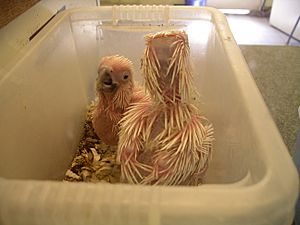
Cockatoos are monogamous, meaning they have one partner for many years. Many birds find a partner in their flock before they are old enough to breed. Females usually start breeding between three and seven years old, and males are often older. They wait to breed so they can learn how to raise their young, which takes a long time for cockatoos. Young cockatoos can stay with their parents for up to a year! Cockatoos often return to the same nesting spots year after year.
Like most parrots, cockatoos build their nests in holes in trees. They can't dig these holes themselves. The holes are usually formed when branches break off or when insects or fungi damage the wood. These holes can be hard to find, so cockatoos often compete with other birds and animals for nesting spots. Cockatoos usually choose holes that are just a little bigger than themselves. They prefer nesting high up in trees, about 7 or 8 meters (23 to 26 ft) off the ground, and close to water and food.
They line their nests with sticks, wood chips, and leaves. Cockatoo eggs are oval and white. The number of eggs they lay depends on the species. Large cockatoos, like the palm cockatoo, lay only one egg. Smaller species can lay between two and eight eggs. Sometimes, if the first set of eggs doesn't hatch, they can lay a second set. About 20% of eggs are not fertile.
For black cockatoos, only the female sits on the eggs and takes care of the young. The male brings her food. For other species, both parents share these duties. When cockatoo chicks are born, they are covered in yellowish fuzz, except for palm cockatoo chicks, which are born naked. The time it takes for eggs to hatch depends on the species' size. Smaller cockatiels hatch in about 20 days, while larger black cockatoos take up to 29 days.
The time chicks spend in the nest also depends on their size. Larger species stay in the nest longer. During this time, they grow their juvenile feathers. They grow quickly, reaching almost their adult weight before they leave the nest. If there isn't enough food or the weather is bad, the chicks might not grow as well.
What Do Cockatoos Eat?
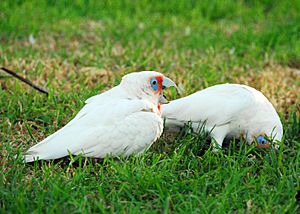
Cockatoos eat many different kinds of plant foods. Seeds are a big part of their diet. They use their strong bills to open the seeds. Some cockatoos, like galahs and corellas, mostly find food on the ground. Others prefer to eat in trees. Ground-feeding species often forage in flocks. They might form tight groups where seeds are plentiful or spread out when food is scarce. They also like open areas where they can see predators coming.
Many cockatoos find food in the tops of trees. They eat seeds from cones or gumnuts, which are common in Australia's dry areas. These hard seed pods are too tough for many animals to open, but cockatoos can crack them with their strong bills. If a nut or fruit is on a small branch that can't hold the cockatoo's weight, the bird will bend the branch towards itself and hold it with its foot.
While some cockatoos eat a wide variety of foods, others are specialists. For example, the glossy black cockatoo mainly eats the cones from a specific type of tree. It holds the cones with its foot and shreds them to get the seeds out. Some species also eat a lot of insects, especially when they are breeding. The yellow-tailed black cockatoo eats mostly insects, using its large bill to pull grubs from rotting wood.
The amount of time cockatoos spend looking for food changes with the seasons. When there's plenty of food, they might only need to feed for a few hours in the morning and evening. The rest of the day they spend resting or cleaning their feathers. But in winter, they might spend most of the day foraging. They need more food when they are breeding. Cockatoos have a special pouch in their throat called a "crop" where they can store food to digest later.
Dangers and Threats
Cockatoos can be hunted by birds of prey like peregrine falcons and wedge-tailed eagles. Their eggs and chicks in nests are also in danger from animals like monitor lizards, snakes, and rats. Sometimes, other birds, like galahs, might even kill glossy black cockatoo chicks when competing for nesting spots. Bad storms can flood nests and drown the young.
Like other parrots, cockatoos can get a disease called psittacine beak and feather disease (PBFD). This virus causes feather loss and beak problems and weakens the bird's immune system. It's common in sulphur-crested cockatoos, little corellas, and galahs. While it might not harm large, healthy wild populations much, it can be very dangerous for smaller groups of stressed birds.
Smart Birds: Social Learning
Cockatoos are very smart and can learn new things by watching each other. In Australia, scientists and people who watch birds noticed that cockatoos learned to open garbage bins. This skill spread quickly to nearby areas as birds copied each other. What's more, cockatoos in different areas even came up with their own unique ways to open the bins!
Cockatoos and Humans

Human activities have affected cockatoos in different ways. Some species that live in open areas have benefited from changes humans have made to the land. They have more reliable food sources and water, and they've learned to eat new kinds of food. However, cockatoos that live mostly in forests have suffered a lot from habitat destruction because their homes are being cut down. These birds often have very specific diets and can't easily adapt to new foods.
Cockatoos as Pests
Some cockatoo species can be a big problem for farmers. They can damage crops. People try to control them using different methods. They also can be a nuisance in cities because they chew on things. In the wild, they chew wood to keep their bills sharp. But in cities, they might chew on outdoor furniture, window frames, or even electrical wires. Sulphur-crested cockatoos have even been known to strip sealant from buildings!
In Australia, some cockatoo species like the long-billed corella, sulphur-crested cockatoo, and galah have grown in numbers because of human changes to the land. They can cause damage to crops, fruit trees, and even houses. The Tanimbar corella is also a pest on Yamdena Island, where it raids corn crops. Even some rare species, like the Carnaby's black cockatoo, can cause problems by damaging pine trees and fruit crops.
Protecting Cockatoos
According to conservation groups, seven cockatoo species are considered "vulnerable" or worse, and one is "near-threatened." Two species, the red-vented cockatoo and the yellow-crested cockatoo, are "critically endangered," meaning they are at very high risk of disappearing forever.
The biggest threats to cockatoos are losing their homes and the illegal wildlife trade. All cockatoos need trees for nesting, so losing trees is a big problem. Many species also live in small areas or on small islands, making them very sensitive to habitat loss. Cockatoos are popular pets, and catching and selling wild birds has threatened some species. Even though it's now illegal to catch many species, the trade continues secretly. Birds are often smuggled in cruel ways, leading to many deaths.
To protect cockatoos, most species (except the cockatiel) are protected by an international agreement called CITES. This agreement controls how wild-caught parrots can be imported and exported. Some of the most endangered cockatoos are on CITES Appendix I, which means they have the highest level of protection.
Cockatoos as Pets
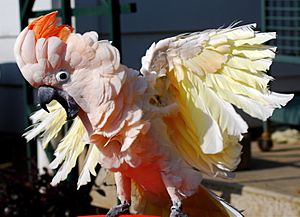
Cockatoos are kept as pets because they are beautiful, smart, and have fun personalities. However, they can be challenging pets. They are not usually good at mimicking human speech, though the little corella is known for talking. Wild cockatoos have even learned human words from former pet birds that joined their flocks! Cockatoos are social animals and need a lot of attention. They can get lonely if left in a cage by themselves for too long.
The cockatiel is the most common cockatoo kept as a pet. White cockatoos are also more often seen as pets than black cockatoos. Black cockatoos are rare in zoos outside Australia because of strict rules about exporting Australian wildlife.
Cockatoos can be very loving with their owners but demand a lot of attention. They are also very curious and need a constant supply of things to play with, chew, and even take apart. If parrots get bored in captivity, they might start pulling out their own feathers. Other challenges include their painful bites and very loud screeches. The salmon-crested and white cockatoos are especially known for being noisy. All cockatoos produce a fine powder on their feathers, which can cause allergies in some people. Generally, smaller and quieter cockatoo species, like Goffin's cockatoo and galahs, are easier to keep as pets.
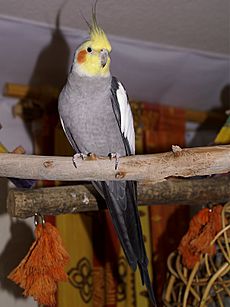
Larger cockatoos can live for 30 to 70 years, or even longer! Cockatiels can live for about 20 years. This means owning a cockatoo is a very long-term commitment. The oldest cockatoo in captivity was a pink cockatoo named Cookie, who lived to be 83 years old at Brookfield Zoo in Chicago. There are also stories of cockatoos living to be 90 or even 100 years old!
Trained cockatoos sometimes perform in bird shows at zoos. They often respond more to petting or praise than to food. Cockatoos can also be taught to wear a special harness, so their owners can take them outside. They have even been used in animal-assisted therapy to help people in nursing homes.
Cockatoos often react strongly to music. Many videos show them dancing to popular songs. One cockatoo named Snowball even showed that he could understand music and move his body to the beat!
Cockatoos in Culture
One of the first times a cockatoo was shown in European art was in a painting from 1496 by Andrea Mantegna called Madonna della Vittoria. Later, cockatoos appeared in paintings by Dutch and Hungarian artists. An English painting from the 1700s, An Experiment on a Bird in the Air Pump, shows a cockatoo in a dramatic scene. In Australia, cockatoos were often used as decorations on buildings in the early 1900s.
The gang-gang cockatoo is the official bird symbol of the Australian Capital Territory. The palm cockatoo is used as a symbol by the World Parrot Trust because of its unique look.
In the 1970s, two police TV shows and movies featured main characters with pet cockatoos. This made cockatoos very popular pets at the time. Cockatoos have also been used a lot in advertising.
Images for kids
See also
 In Spanish: Cacatúas para niños
In Spanish: Cacatúas para niños


